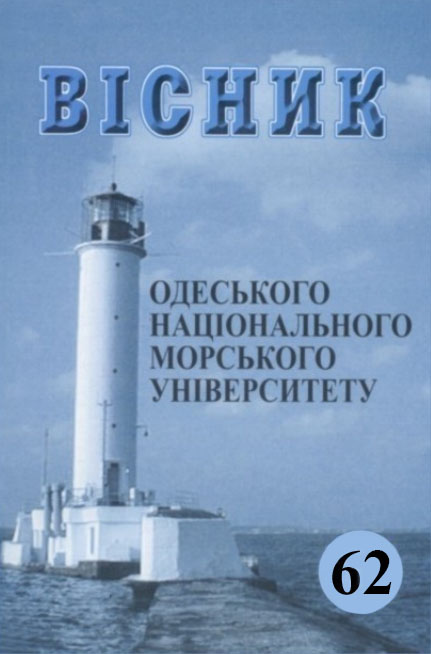Integrated management of exhaust gases of marine diesel engines as a way to ensure their environmental performance
Main Article Content
Abstract
The analysis of ship Diesel engines exhaust gases, assured the reduction of Nitrogen oxide emission into environmental, has been performed. The recirculation exhaust gases system has been analyses, when at 0-21 % of gases return to charge air receiver, as well as the system of exhaust gases by-pass, when 0-10 % of gases return to the exhaust receiver, without preliminary passing through the gas turbine. The result of research on influence of recirculation systems and exhaust gases by-pass to the ecological and economic parameters of ship engine 16V32 Wartsila-Sulzer has been provided. The level of exhaust gases recirculation has been changed from 0- 21 % and has been controlled on the coefficient excess air ratio during appliance of recirculation and during working of diesel without appliance of recalculated gases. The level of exhaust gases by- pass has been changed into the range 0-6 % and has been controlled based on the quantity of exhaust gases-general and going to by-pass. Experiments provide that the usage of exhaust gases recirculation into the range of Diesel engine operation service load 16V32 Wartsila-Sulzer 35-95 % assure the decrease of nitrogen oxide emission on 2,4-33,6 %. During this the increasing of specific effective fuel consumption on 3,3-2,2 % is performed. The by-pass system of exhaust gases into the range of Diesel engine charge 16V32 of Wartsila-Sulzer 35-95 % assure the oxide nitrogen emission decreasing on 6,5-17,9 % at simultaneous increasing of specific fuel consumption on 2,7-1,2 %. The appliance of complex system of exhaust gases operation (combining recirculation system and exhaust gases by-pass) assure maximum decrease of oxide nitrogen emission at minimum increase of specific effective fuel consumption. In the meantime for the effective combination of recirculation system and by-pass (that is for the current Diesel engine 16V32 Wartsila-Sulzer comes to 15 % and 6 %) the oxide nitrogen emission decrease assure on 31,27-38,23 % with respective increasing of specific effective fuel consumption on 2,68-1,11 %. The usage of complex system exhaust gases operation of Diesel engine is the most effective measure to assure its ecological working parameters.
Article Details
References
2. Sagin, S.V., Semenov, O.V. (2016). Marine Slow-Speed Diesel En-gine Diagnosis with View to Cylinder Oil Specification. American Journal of Applied Sciences, vol. 13, no. 5, pp. 618-627. DOI: 10.3844/ajassp.2016.618.627.
3. Kuropyatnyk, O.А. (2018). Znyzhennya emisiyi oksydiv azotu sud-novyx dyzeliv metodom perepusku vypusknyx gaziv [Reduction of nitrogen oxides of marine diesel by exhaust gas bypass]. Visnyk Odeskogo nacionalnogo morskogo unyversytetu, no. 4(57), pp. 98-108.
4. Sagin, S.V., Kuropyatnyk, О.А. (2018). The Use of Exhaust Gas Recirculation for Ensuring the Environmental Performance of Marine Diesel Engines. OUR SEA: International Journal of Mari-time Science & Technology, vol. 65, no 2, pp. 78-86. doi.org/ 10.17818/NM/ 2018/2.3.
5. Zablotsky, Yu.V., Sagin, S.V. (2016). Enhancing Fuel Efficiency and Environmental Specifications of a Marine Diesel When using Fuel Additives. Indian Journal of Science and Technology, vol. 9, no. 46, pp. 353-362. DOI: 10.17485/ijst/2016/v9i46/107516.
6. Kuropyatnyk, O.A., Sagin, S.V. (2019). Exhaust Gas Recirculation as a Major Technique Designed to Reduce NOх Emissions from Marine Diesel Engines. OUR SEA: International Journal of Mari-time Science & Technology, vol. 66, no. 1, pp. 1-9. doi.org/ 10.17818/ NM/2019/1.1.
7. Yeryganov, O., Varbanets, R. (2018). Features of the fastest pres-sure growth point during compression stroke. Diagnostyka, vol. 19, no. 2, pp. 71-76. http://dx.doi.org/ 10.29354/diag/89729.
8. Sagin, S.V., Solodovnikov, V.G. (2017). Estimation of Operational Properties of Lubricant Coolant Liquids by Optical Methods. International Journal of Applied Engineering Research, vol. 12, no. 19, pp. 8380-8391.
9. Kuropyatnyk, O.A. (2020). Reducing the emission of nitrogen oxides from marine diesel engines. Materials of the International Conference «Scientific research of the SCO countries: synergy and integration», Beijing, PRC, January 25, 2020, vol. 2, pp. 154-160. DOI. 10.34660/INF. 2020.24.53689.
10. Sagin, S.V., Kuropyatnyk, О.А. (2017) Application of the system of recirculation of exhaust gases for the reduction of the concentra-tion of nitric oxides in the exhaust gases of the ship diesels. Ameri-can Scientific Journal, no. 15, iss. 2, pp. 67-71.
